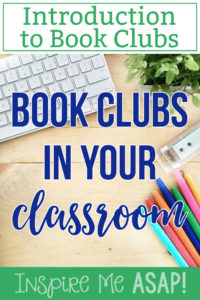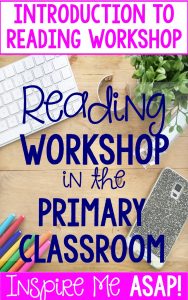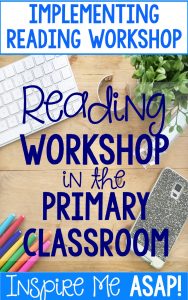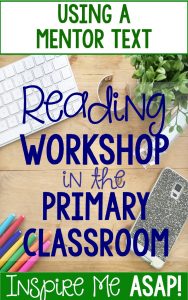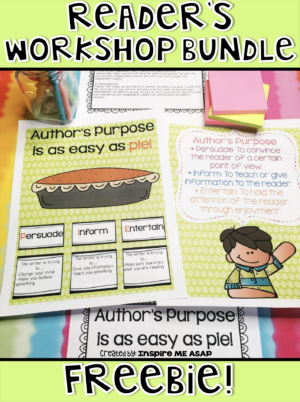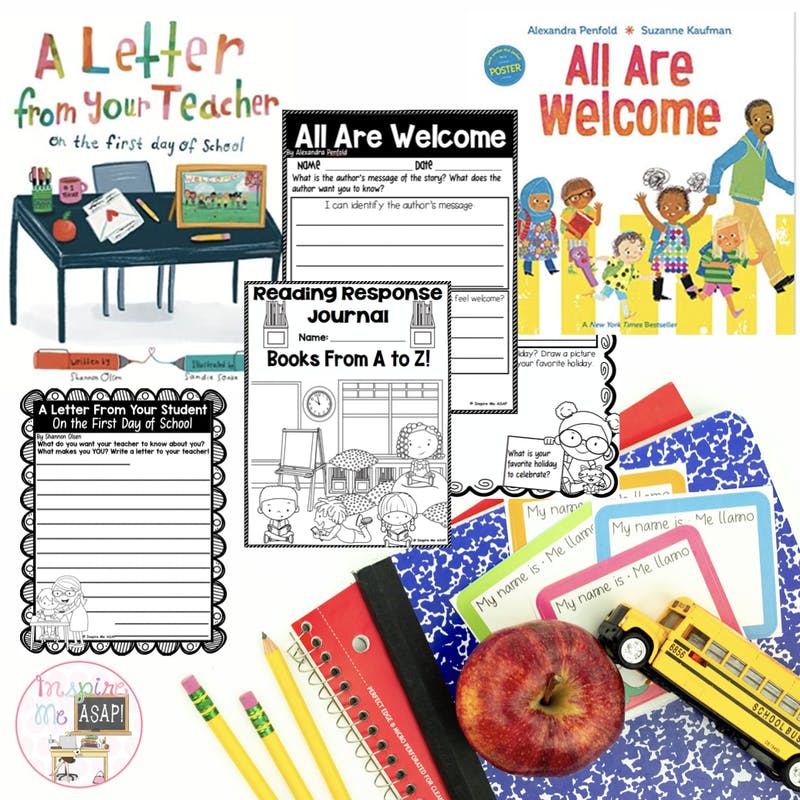
This is my fourth blog post about implementing reading workshop in the primary classroom. In my previous posts, I introduced what reading workshop is and benefits of using this approach to teach reading in your classroom. In my last post, I wrote about how to implement reading workshop into your classroom, whether it be at the beginning of a new school year or any time during the school year, and shared my must-teach procedural mini-lessons. Click on the links below to check up on reading all the blog posts in this series:
Introduction to Reading Workshop
Using a Mentor Text in Reading Workshop
In this blog post, I will write about how to use reading partnerships, and book clubs, as a powerful component of reading workshop.
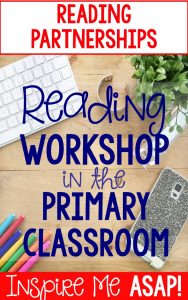
Now that you have reading workshop sucessfully implemented into your classroom, you are ready to implement another component to it- reading partnerships! When I taught first grade, I would call this time, “Book Buddies.” Simply put, reading partnerships are teacher assigned ability-based partnerships where two students read and discuss books together.

Why is it worth the time you invest to implement reading partnerships? Let’s begin with stating the importance of providing time every day for students to work with ability-based reading partners.

* Students learn to problem solve, communicate, and work cooperatively with their peers.
* Students have the opportunity to reread texts which improves reading fluency.
* Students have authentic opportunities to integrate reading and writing.
* Students have the opportunity to have in-depth conversations with their friends about the texts they are reading- this can pave the way to start book clubs later on in the school year.
* Students’ reading stamina improves and they are spending quality time reading just-right books.
* Students are held accountable during reading workshop time.
* Students foster a LOVE for reading!!

Now you know the “WHY” behind my implementation of reading partnerships, I will share my top 5 tips for successfully implementing reading partnerships into your primary classroom. It is my hope that you will learn some valuable ways to implement reading partnerships this school year!

When selecting reading partners for your class, consider the benefits of using teacher assigned, long term, ability-based partnerships. This might be different than what you are currently doing, if your belief is to match a weaker reader with a stronger reader. Instead, partnerships are created under the premise that two strong readers are placed together and two weaker readers are placed together.
When I first started teaching, I did not assign reading partners. When it was time to buddy read, I just had my students randomly choose their partner every day. After honestly reflecting on this practice, I realized that they spent way too much time choosing a partner. It often became a popularity contest and my students frequently had “hurt feelings” if someone did not want to read with them. “But it is MY turn to read with you today!” Or, “I PROMISE I will read with you tomorrow!” I did not like how much time was wasted when my students were picking their partners. Instead of focusing on the books they were reading, and the work they were doing together, my students were more focused on who they would be reading with.
This school year was my first year out of the classroom; I was an instructional coach. I worked with a third grade teacher to help her implement reading partners within her reading workshop block. One area that she was struggling with was off-task behavior of her readers during this time. The first thing that we did in our work together, was to analyze the reading levels of her students. She thought she was helping her weakest students by pairing them with a stronger reader. For example, one student (I will call her Claire) who was chapter books was paired with a student (I will call him Matthew) who was reading books with one predictable sentence on a page. It was not surprising that Claire and Matthew (despite their kind personalities), were not a good match. While Claire wanted to read Magic TreeHouse Books, Matthew struggled with his fluency and decoding when it was his turn to read. Both students eventually became frustrated with each other, causing off-task behavior. The teacher and I worked together to revise her list of readers and grouped them by ability, along with taking their personality and reading interests in account.
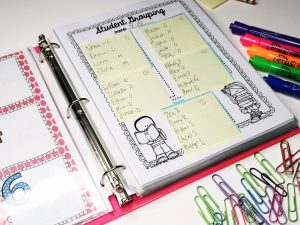
By switching to teacher assigned, ability-based partnerships, I have noticed a big difference in engagement, focus, and time on-task with reading! I now assign reading partners in October, as I learn more about my students as readers through reading conferences, group work, and formal reading assessments. (I do allow my students to choose their reading partners for the first few weeks of school.) For example, I might have one girl who is an Fountas and Pinnell instructional reading level of P and another girl (or boy!!) who is an Fountas and Pinnell instructional reading level of Q. These two students also have a common interest of reading mysteries and their personalities complement each other. They will make perfect partners!
In my own classroom, I like to introduce reading partners to my students by giving an analogy of training for a marathon- true story. I have run 2 marathons. For both marathons I had a different training partner which was at the same ability as me. We ran our long training runs together, supported each other, and had the same vision for race day. Our joint goal was to cross the finish line with a smile on our face. We did not have a goal time in mind. It would not have been beneficial to train with a friend who was a super fast runner or with a friend who walked the entire race. Both of us would have been frustrated and irritated with the other person. By running with a friend who was just about the same pace as me and the same goal as me, I was able to be challenged appropriately.
What analogy can you share with your readers? Share YOUR real-life story with your students…I guarantee they will remember it!
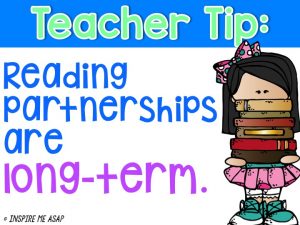
Another important component of reading partnerships is the duration of time the partners remain together. In order to reap the rewards of reading partnerships, students are kept together as reading partners for at least a couple of months- hence the term long term partnerships! When students stick with the same partner for a considerable amount of time, it really allows for the opportunity to focus on READING. They are no longer switching books or partners every day. Instead, partners quickly start their reading right where they left off the previous day. There is a continuous flow of reading and conversation that does not get interrupted.
I like to assign reading partners every quarter. So, throughout the course of a school year, I will create partnerships only four times. There are a few exceptions to this. For example, based on the feedback I get from students, I may assign the SAME partner for another round of partnerships. (More on this in a bit!)
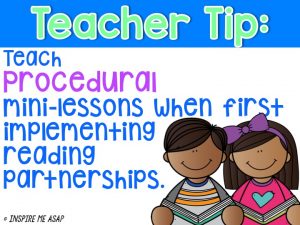
Teaching procedural mini-lessons where first implementing reading partnerships is an absolute must! Remember how you took the time to teach procedural mini-lessons about your reading workshop expectations? ( If not, read more: Implementing Reading Workshop: Five MUST-TEACH Procedural Mini-Lessons ) The same goes for starting reading partnerships. In order to have them run smoothly and successfully, which will allow YOU time to conference with readers, then you will have to invest time in teaching several different mini-lessons about the procedures of reading partnerships.
*Do you have double copy books for partners to read? If not, what types of books will students read during this time?
*What happens if a student is absent?
*What if two students argue and don’t get along?
*What if a student has to go the bathroom when it is reading partnership time?
*What if students can’t agree on a book to read?
Although it may sound like a lot of “What if…” questions, these are actually pretty important things that you will establish a procedure for because they will come up. Before I announce assignments for reading partners, I make sure to teach mini-lessons at the start of my reading workshop, which teaches the expectations of this time.

Although this is a really old anchor chart, it gives an example of how I create an anchor chart during our mini-lesson. The focus of this procedural mini-lesson was, “Be a problem solver during reading partnerships time.” I wrote several “possible problems” that might arise as they read with their partner. As a class, we discussed the best solution for that problem. Students wrote the response on the anchor chart and we kept this up ALL YEAR LONG. (We also added to this throughout the year!) When a student asked me a question that he/she should know the answer to, I simply pointed to our anchor chart and they answered their own question. :)
A few months ago, I had a teacher who purchased my Reading Workshop Unit 1 resource email me about reading partnerships. She was asking if I had a video of any students at reading partnerships, that she could show her students as an example. Although it is a great idea, I was not able to share any examples. Instead, I recommended that she contact her former students and invite them into the classroom to model partner reading.
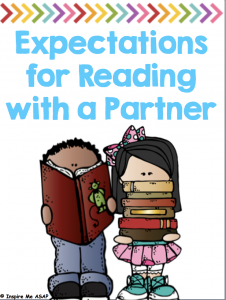 When I do this in my classroom, we have a class discussion about what we notice. Students commented, “They both held the book and took turns reading.” “They were sitting next to each other.” “They talked about the book.” All of these behaviors became part of our anchor chart of expected behaviors with a reading partner.
When I do this in my classroom, we have a class discussion about what we notice. Students commented, “They both held the book and took turns reading.” “They were sitting next to each other.” “They talked about the book.” All of these behaviors became part of our anchor chart of expected behaviors with a reading partner.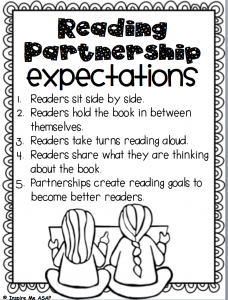
As I see partners engage in appropriate behaviors, I like to take their picture (not as they are posing, but when they are engaged in their reading or conversation!). I post these pictures on our anchor chart for expected behaviors and it serves as an effective visual reminder. I also print out their pictures and present them to the students when I meet with them for a conference. They glue down the picture in their reader’s notebook and write a caption to the photo. :)
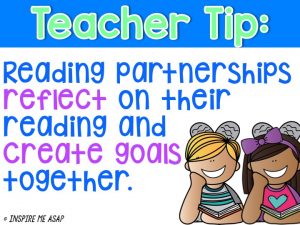
Remember the analogy running analogy I shared earlier? My training partner and I had similar goals- to finish the marathon with smiles on our faces. Imagine if I was training with someone who had a four hour goal, or who wanted to run without walking the entire race? Again, I use analogy when introducing goal setting with partners. At this point of the year, my students have experience with setting individual reading goals, but setting goals with their partner is new.
I try to conference with one partnership a day, which lasts for about 20 minutes. I follow the same format as a typical reading conference. I begin by just listening to them read and discuss the text. I then give them a compliment and offer an area for improvement. We work together to develop a common goal based on that feedback.
Each student fills out their own goal setting template and glues it down in their readers notebook. In the example above, the strength of this partnership is: “My partner and I do not waste time choosing a book to read. We get started right away.” The area for improvement is: “My parter and I can improve by having a discussion about what we read.” The goal is: “My goal is to share one thing I am thinking about the text on every page.”
In addition to creating reading goals, I also have my students fill out a self-reflection at the end of every quarter. Prior to starting the next round of partnership, I ask my students to reflect about how their current round of partnerships went.
I absolutely LOVE reading their reflections, as I gain so much information from their honest opinions and thoughts. A couple of years ago, I had two girls who stayed together as reading partners for the entire year. Yep. The entire year. Contrary to what you would think, they were not best friends. In fact, they did not even sit by each other at lunch or play together at recess. However, they truly understood the importance of having a “just-right” reading partner that complimented yourself as a reader. Throughout the year, they read one Harry Potter book after another. They were obsessed- in a good way. I did have to eventually encourage them to try a new genre during their reading conference, though. :) For every self-reflection, they wrote the same thing and requested to be partners….again and again.
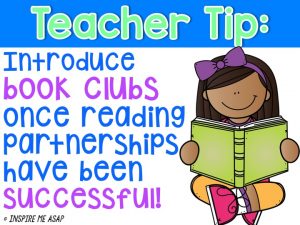
Reading partnerships are a great way to get your students TALKING about books! It provides your students with the opportunity to discuss literature in a meaningful and engaging way. You are also meeting Speaking and Listening CCSS.
CCSS.ELA-Literacy.SL.1.1 Participate in collaborative conversations with diverse partners about grade level topics and texts with peers and adults in small and larger groups.
CCSS.ELA-Literacy.SL.1.1a Follow agreed-upon rules for discussions (e.g., listening to others with care, speaking one at a time about the topics and texts under discussion).
CCSS.ELA-Literacy.SL.1.1b Build on others’ talk in conversations by responding to the comments of others through multiple exchanges.
CCSS.ELA-Literacy.SL.1.1c Ask questions to clear up any confusion about the topics and texts under discussion.
After the students get into the routine and understand the expectations of working with a reading partner, I then introduce book clubs. I purposely group two partnerships in one book club. The book clubs do not read the book aloud together, but they meet over the course of a month and read the assigned portion of the text independently.

I am not going to go into depth about the benefits of book clubs and how I implement them into my classroom, as I wrote a series of blog posts about book clubs. You can get started by reading the first post: Introduction to Book Clubs.
Are you ready to start reading partnerships or book clubs in your classroom this year? I would love to hear from you!
Take a sneak peak at what is next in this 8 post Reading Workshop series!
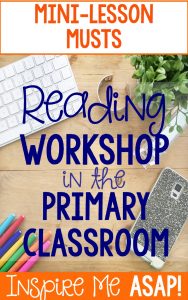


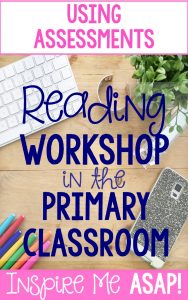

Do you like the ideas presented in this blog post? If so, check out my Reading workshop resources below. You can purchase each one of the units separately, or you can save money by purchasing the bundle. Please let me know if you have any questions!
Units included in my Reading Workshop bundle:
Unit 1, Implementing Reading Workshop in your Primary Classroom



Unit 2, Reading Workshop: Reading is Thinking
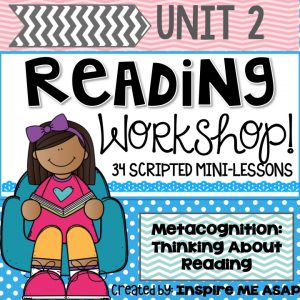
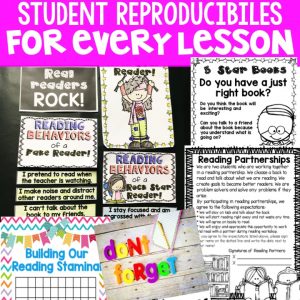
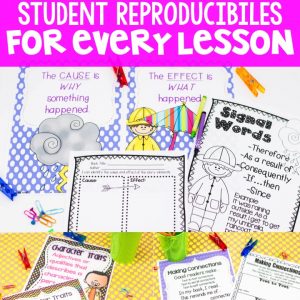
Unit 3, Implementing Reader’s Notebooks
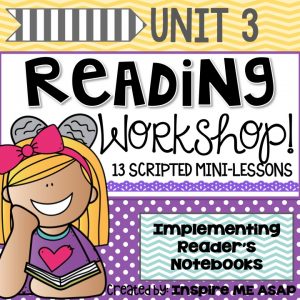
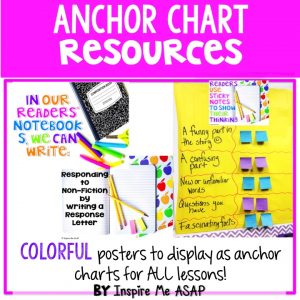
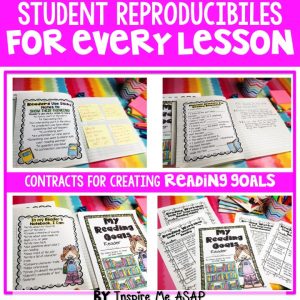
Unit 4, Informational Text Features
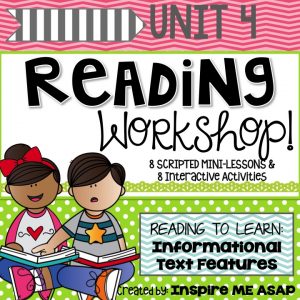
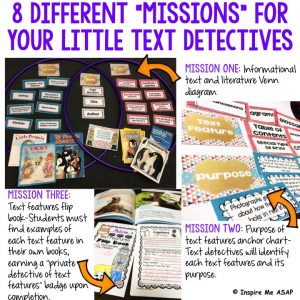
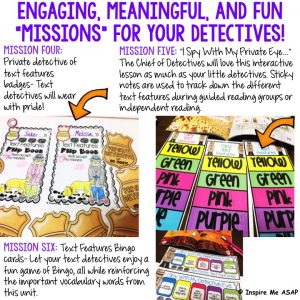
Unit 5, Character Study Unit
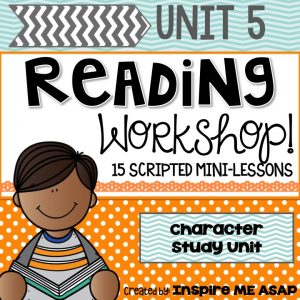
Unit 6, Dive Deep with Book Clubs
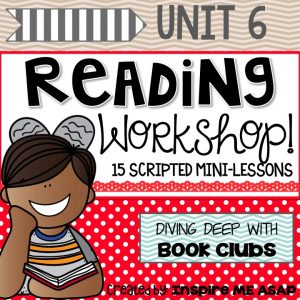


Other resources included in this bundle:
Reading Workshop Book Awards Celebration
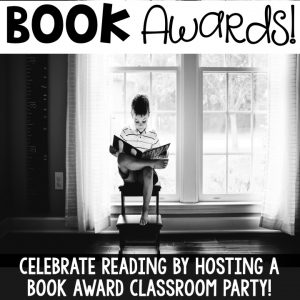
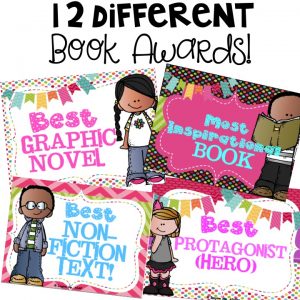
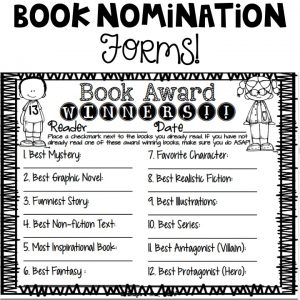
You can purchase the BUNDLE on my Teachers Pay Teachers store by clicking HERE.
Save 10% by purchasing this bundle directly from my website.




